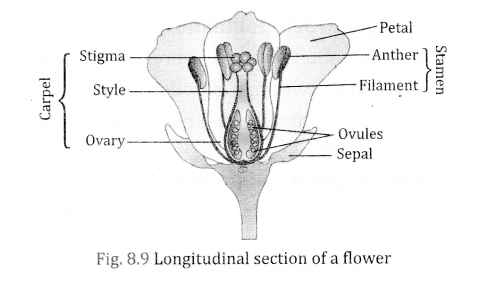How do Organisms Reproduce
Chapter End Questions
1.Asexual reproduction takes place through budding in?
- amoeba
- yeast
- plasmodium
- leishmania
ans:
2.Which of the following is not a part of the female reproductive system in human beings?
- Ovary
- Uterus
- Vas deferens
- Fallopian tube
ans:
3.The anthers contains?
- sepals
- ovules
- carpel
- pollen grains
ans:
4.What are the advantages of sexual reproduction over asexual reproduction?
ans:
- Sexual reproduction provides opportunity - for new recombination of genes thus causes genetic variations, which is not applicable to asexual reproduction
- Sexual reproduction plays an important role in evolution of new species but the asexual reproduction does not
5.What are the functions performed by the testis in human beings?
ans:
- They form sperms from the germinal cells present in the seminiferous tubules
- The hormone testosterone secreted by the Leydig cells induces secondary sexual characters in male
6.Why does menstruation occur?
ans:In every month as one of the ovaries releases ovum and tfie uterine wall thickens and prepares itself for receiving the developing zygote. When the egg is not fertilised, the level of progesterone starts decreasing, due to which nourishment to the endometrium is stopped. As a result, the lining of uterine wall slowly breaks and the discharge of unfertilised egg along with ruptured endometrium and mucus causes menstruation in a human female
7.Draw a labeled diagram of the longitudinal section of a flower?
ans:

8.What are the different methods of contraception?
ans:
Methods of Contraception
Barrier Methods Physical devices which prevent the entry of sperms into the female reproductive tract come under barrier methods. Condoms, diaphragms and cervical caps can be used as barrier method.
Chemical Methods In these methods, specific drugs are used by the females to avoid pregnancy. These drugs change the hormonal balance of the body so that eggs are not released and fertilisation does not occur. These drugs are taken orally as pills, and therefore, called Oral Contraceptives (OCs).
IUCDs (Intra Uterine Contraceptive Devices)Lippe loop or copper-T are contraceptive devices which are placed inside the uterus to prevent implantation of the embryo.
Surgical Methods Vasectomy in males and tubectomy in females are surgical methods of population control.
- In males, a small portion of the vas deferens is surgically removed and then cut-ends are tied to prevent the transfer of sperm. This is called vasectomy
- In females, a small portion of the fallopian tube is surgically removed and the cut-ends are tied to prevent the passage of egg in the uterus. This is called tubectomy
9.How are the modes for reproduction different in unicellular and multicellular organisms?
ans:The unicellular organisms reproduce generally by asexual reproduction like budding, binary and multiple fissions. However, some unicellular forms also exhibit primitive types of sexual reproduction like conjugation found in some types of bacteria.
The multicellular organisms have a complex body structure and reproduce sexually by the distinct sexual body parts. However, some lower multicellular organisms such as hydra reproduces sexually in poor feeding conditions
10.How does reproduction help in providing stability to population of species?
ans:Every species has to struggle for its existence. A large number of the population of a particular species is removed by the predators or by the unfavourable environmental conditions. Reproduction is the only way to replenish the lost section of the population. If the organisms of species do not reproduce, their species will foil to exist
11.What could be the reasons for adopting contraceptive methods?
ans:
Contraceptive methods are adopted to:
- prevent unwanted conception
- have sufficient gap between the successive births